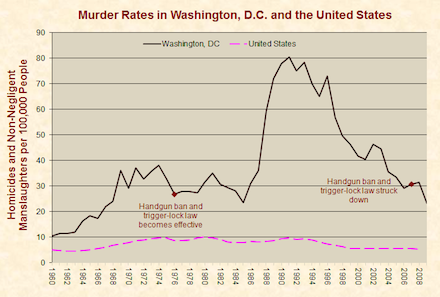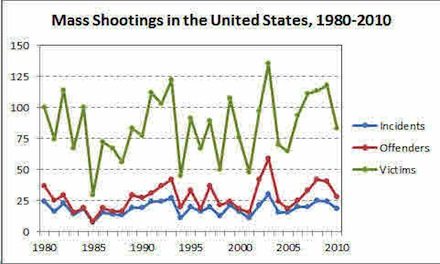Homicides are down while gun ownership is up, rampages are not increasing, and gun laws don’t seem to have changed any homicide rates we can look at. So why are we so obsessed with gun control?
———
Do you believe in science? I do. I believe that truth can be ascertained reasonably well from research, data and statistics, and that its applications can be understood prudently using logic.
There are truths on both sides of the issue of gun control. Easy access to guns undoubtedly makes the job of someone who wants to kill someone else much easier, for example. But in the wake of the horrific school shooting in Sandy Hook, Connecticut, the renewed calls for more of what is commonly called ‘gun control’ seem to directly ignore what the data has to say. Contrary to what gun control advocates seem to think, the research does not suggest that more restrictions on guns are the best answer to America’s violence.
Let me explain this by quibbling with Piers Morgan, who I rather like and – as a fellow European working in American media – feel some kinship with. Piers is under fire as a result of his recent loud cheerleading of the gun control cause, and subsequently became the target of a silly petition to the White House demanding his deportation (the attention from which he seems to be enjoying immensely).
First, it’s a little disingenuous of Piers to take the total number of homicides involving firearms in the United States (12,000) and compare it to the total number of homicides involving firearms in the United Kingdom (35). He is, of course, making the point that gun control is working in Britain, keeping the gun murder rate low.
The first and most obvious little objection to this is that America is five times more populous, which means Piers’ comparison is exaggerated by five times its truthful self. The real number, therefore, is not 12,000 to 35; it is 3.7 to 0.4 (murders involving firearms per 100,000 people)1. Unfortunately this means that even adjusting for the population difference doesn’t equalize the homicide rates between the two nations. America’s rate is still much higher: 3.7 murders involving firearms per 100,000 people in the U.S. compares to only 0.4 in the United Kingdom.
So is Piers right? Gun control and a lower murder rate in the U.K. means gun control works?
Well, no. Good science involves holding such a hypothesis up to scrutiny, ruling out other factors that may contribute to the data.
Since most guns are now illegal in the U.K., Piers’ appeal to our mutual homeland to prove his case is a perfect place to start. The gun laws enacted in 1968, 1988 and 1997 are among the strictest in the world2, essentially removing firearms ownership of the sort Americans enjoy today. If Britain’s comparatively low murder rate is a result of these gun control laws, the data should tell us. A look at the pre-ban murder rates compared with the murder rates today should be all we need to verify Piers’ assertion. Is he right? Will we find that there’s been a dramatic drop in homicides in the United Kingdom since gun control was put into place?
Not exactly. In fact, the U.K. homicide rate today is almost exactly the same as it was 30 years ago, before the legislation was enacted!3 British people are killing each other at roughly the same rate today as they were in 1982, even though the most recent gun bans have now been in effect for 15 years.
Piers might reply that the U.K. murder rate is now on its way down from a high in 2002. Maybe this proves that the laws’ effects were merely delayed by some years, but are now working? Probably not: first, they aren’t any lower than they were before the legislation, as I’ve pointed out. If even the most lenient forms of gun control are to bring America’s murder rate down (banning only so-called ‘assault weapons’ as the president is suggesting, for example), then why didn’t a greatly stricter form of gun control bring Britain’s murder rate down? Second, U.S. rates have been falling too – without gun control – and for longer, which prevents us from concluding that gun control in Britain is the reason why they’re falling in that country now.
Not only have the U.S. murder rates been falling; U.S. murder rates are lower today than at any time since 1965. I repeat: the U.S. murder rate is at a 50-year low!4 Not only that, but gun laws have been getting more lenient in that time too. Only a handful of states had concealed firearms programs for citizens when the violent crime rate peaked. Today, 41 states either allow carrying concealed guns without a permit or have “shall issue†laws that make it easy for just about any noncriminal to get a permit.
So, more guns are around with more freedom regarding their use than ever before. There are now an estimated 300 million guns in America, an ever-increasing percentage of which are being used to kill an ever-decreasing number of people.
Further destroying Piers’ supposed correlation are those pesky countries with high gun ownership and low murder rates like Switzerland or Canada, or countries with low gun ownership and higher murder rates like Denmark, not to mention countries with very tight gun control and yet much higher murder rates than the U.S., like Mexico. Gun control in Mexico appears to have worked about as well as its drug laws.5
And what is the success of gun control by cities in America who have enacted it? Washington D.C. banned handguns entirely in 1976, and mandated a trigger lock on rifles and shotguns. Not only didn’t it work, it actually had the inverse effect before being finally struck down by the U.S. Supreme Court in 2008. During the years in which such gun control was in effect, the Washington, D.C. murder rate averaged 73 percent higher than it was at the outset of the law, while the U.S. murder rate averaged 11 percent lower.6 Similar observations have been made in Chicago, leading 4 out of the 5 suburbs of the city to repeal their handgun bans too.
Good science would dictate that we suspect that Piers is simply wrong about this, along with all others whose primary response to violence in America is to assert the ‘solution’ of gun control. Perhaps other factors are to blame for America having higher rates of violence than most other first-world countries? The U.S. is a rare nation with a unique, dramatic, violent and recent history. Its original motto, E Pluribus Unum (out of many, one), may overstate the painlessness with which so many cultures and races can be so hastily mixed, and then given unprecedented liberty. An estimated 70 percent of gun homicides involve gang activity, the most stark outworking of racial tension. Even gang activity, however, has been decreasing for 35 years.
Despite a decreasing level of all types of violent crime including murder, and despite the strong evidence that suggests it won’t work anyway, America is now obsessing about the the red herring of gun control. And that’s because this conversation, as Piers Morgan will tell you, isn’t being prompted by the overall murder rate: it’s being prompted by the apparent prevalence of a very specific type of murder: rampage violence, of which the Connecticut school shooting was the most recent example.
We know that the murder rate is going down. But what about rampage homicide (defined by the FBI as the murders of 4 or more people at the same time)? Are these incidents really increasing in number? James Allan Fox, a Northeastern University criminologist, points to FBI figures which say no. About 100 people each year over a 30 year period have been killed in these kinds of events, and that number has remained fairly steady. No increase in rampage violence is occurring, and there is certainly no epidemic.
So the gun control conversation championed by Piers and others is being fueled by a type of crime that isn’t increasing, and accounts for less than 0.01 percent of all homicides, the other 99.99 percent of which are actually decreasing without gun control. Does that make any sense… at all?
This isn’t to say America should sit and do nothing about its murder rate that remains significantly higher than other first-world countries, or about rampage violence. There are questions we can ask which go to the heart of such issues. How can communication be improved between mental health professionals and law enforcement? How can people be encouraged to seek help with people with mental illness or suffering? How can people be rehabilitated after drug abuse instead of locked away in the company of violent offenders? How can we reduce aggressiveness in the culture? How can we reduce poverty? Can we look more closely at income inequality, social mobility and preserving the American dream? How can we improve ‘community’? How can we ensure people have nonjudgmental places to turn when things get tough? Can we finally stop making criminals out of weed consumers?
But we need to keep the issue in perspective. Just because we have a media that is better at reporting certain types of crimes than it is at reporting others does not mean we should let fear of such things control the discourse or form public policy.
None of the above data is new. A review of the issue by prominent Harvard criminologists Don B. Kates and Gary Mauser concluded that gun control wouldn’t work7, along with many other papers which actually supported the opposite finding by John Lott in More Guns, Less Crime that more lenient gun laws – the opposite of gun control – produced decreases in crime; these include Bruce L. Benson, Florida State University, and Brent D. Mast, American Enterprise Institute, David E. Olson, Loyola University Chicago, and Michael D. Maltz, University of Illinois at Chicago, and David B. Mustard, University of Georgia. But I’m not asking you to agree.
One thing is for certain: the data strongly suggests that gun control won’t reduce violent crime, or homicide, or rampage violence. And people shouldn’t be afraid to say so.
John Wright
——
1 National Vital Statistics Reports 2011. [pdf]
2 Firearms (Amendment) Act 1988, Firearms (Amendment) (No.2) Act 1997
3 Home Office Homicides, Firearm Offences and Intimate Violence 2008/09. [pdf]
4 Crime in the United States, FBI Uniform Crime Reports.
5 Mexico’s firearm-related murder rate is 10.0.
6 Uniform Crime Reporting Program, District of Columbia, 1960-2008.
7 Would Banning Firearms Reduce Murder and Suicide? [pdf]



